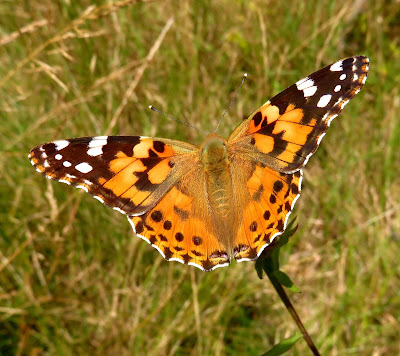Recent sunny days have been ideal for watching butterflies and one rich spot has been the Feldy View cemetery field with its nice mix of grassy meadow and nectar rich flowers.
Brown argus pictured above was seen low down beside the clover flowers or on the clumps of lavender with two seen on Friday 28th and two on Monday 31st.
Brown argus pictured above was seen low down beside the clover flowers or on the clumps of lavender with two seen on Friday 28th and two on Monday 31st.
A smart painted lady was feeding on the lesser knapweed and also lavender flowers on 28th and 30th.
At least eight common blues were fluttering along the grassy paths.
A pair of gatekeepers was seen mating amongst the grass, up to 25 were feeding on knapweeds along one edge of the field.
Several large clumps of lavender were buzzing with bees as well as butterflies including a hummingbird hawkmoth on Monday 31st.
The lesser knapweed had several butterflies feeding on the purple flowers across the meadow.
Other butterflies seen in the field were small tortoiseshell, peacock, meadow brown, speckled wood, small white, large white and holly blue.
Other butterflies seen in the field were small tortoiseshell, peacock, meadow brown, speckled wood, small white, large white and holly blue.
Several butterflies were also seen in the Firs Chase garden such as this comma on Sunday 30th.
Others seen in the garden were red admiral, small tortoiseshell, small white, large white, green-veined white, gatekeeper, speckled wood, holly blue and also a hummingbird hawkmoth visiting some salvia and buddleia on Monday 31st.
Others seen in the garden were red admiral, small tortoiseshell, small white, large white, green-veined white, gatekeeper, speckled wood, holly blue and also a hummingbird hawkmoth visiting some salvia and buddleia on Monday 31st.


















































